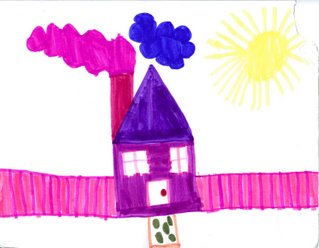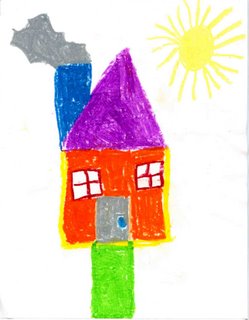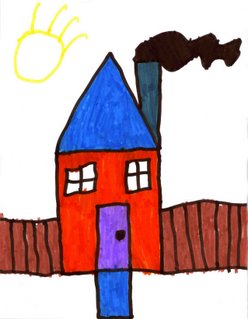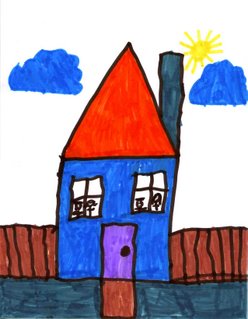 Not long ago I had a conversation with the psychologist from Sweet M's school. She was sharing with me that Sweet M had made all sorts of progress. The first sign of progress was that she was letting the daughter of one of the wealthiest families at the school steal her chair and she wasn't complaining about it. As it was described to me, this little girl was stealing Sweet M's seat just to see what M would do. No one was stopping this little girl from engaging in this provocative behavior. But now Sweet M was tolerating this. I had to wonder about the class(room) politics of this . . . teaching my child to be comfortable when members of a more privileged social class appropriate her place and attempt to provoke her . . . but what was more interesting to me was the next example of Sweet M's progress . . .
Not long ago I had a conversation with the psychologist from Sweet M's school. She was sharing with me that Sweet M had made all sorts of progress. The first sign of progress was that she was letting the daughter of one of the wealthiest families at the school steal her chair and she wasn't complaining about it. As it was described to me, this little girl was stealing Sweet M's seat just to see what M would do. No one was stopping this little girl from engaging in this provocative behavior. But now Sweet M was tolerating this. I had to wonder about the class(room) politics of this . . . teaching my child to be comfortable when members of a more privileged social class appropriate her place and attempt to provoke her . . . but what was more interesting to me was the next example of Sweet M's progress . . .The psychologist went on to tell me that Sweet M is making amazing drawings . . . of female figures.
"First," the psychologist told me, "She outlines the figure, then she colors it in. And she's made many of them."
"I know the motif," I said. "It's sort of a primitivist image of a woman, isn't it? Big hips and bright colors. Sort of a combo of my body type and her babysitter's."
"Oh, no," she said, "It's not primitive at all . . .".
"Oh," I said, "I didn't mean it was primitive. I meant it was primitivist . . . like the art movement."
"Oh, okay," she said. "But what is so interesting is that she makes the outline first, and then colors it in. It's just exactly like her . . . she really needs that structure."
Hmmh, I thought. So now the fact that she outlines her figures is a sign of atypical psychology or neurology.
And now that 1 in 150 children in the U.S. are said to be diagnosed with ASD, one of the things that is going to hardest to navigate is what is a symptom and what just is . . . what just is an amazing and delightful and endearing characteristic of one's child, not a sign of disease or disability or difference. Once a child is labelled PDD-NOS, or ASD, or one of the tags from the DSM pull down list of possibilities, everything about them is up for discussion, as some sign of pathology, where what's bad is bad and what's good is bad, too.
While it may be to our culture's credit that we are recognizing the existence of neurological differences in children, it's also a problem when everything becomes a sign of pathology.
Take these drawings, for example.
Sweet M has been making house pictures ever since her difficult re-entry to her school in the fall. Wanting to be home? Wanting to feel at home? Wanting to find one's way home? Perhaps. Or perhaps a beautiful motif of a house, in the sunshine, rendered in various ways on various days.
Oh, but there are so many of them. I have more than a dozen. So perhaps it's repetitive, obssessive. Who knows? But what I do know, for sure, is that she is trying to find a way to feel at home in the world. And sometimes she finds a way to feel that way . . .








16 comments:
First, I think it's really a pathology of the psychologist that she thinks it's a GOOD thing that M lets herself be bullied...that's wrong on about 1000 levels and I just want to swoop in and give the whole class a big loud lecture (M would be given earplugs).
Second, she draws a beautiful "autistic house". According to my Dad, who was diagnosed in the beginning of the era of ABA, that's actually used in diagnosis sometimes...most NT kids will draw a house with 1 window and a door to the side, autistic kids like symmetry and will draw houses like M's. I like the detail she takes, putting the people inside.
Everytime I read your blog I just want to hug your daughter...
It's the colors that stand out to me----and the careful attention to line and form, and the unassuming symmetry.
Warm thoughts!
Like you and Kassiane, I wouldn't call letting somebody push M around "progress." I'd call it "time for the adult who's noticing it and calling it 'progress' to get off their butt and intervene."
I love M's drawings, though. Those bold lines, the symmetry. And I love how she gives all the people 5 fingers on each hand. (Hands are hard to draw--it's always easier for me to cheat and just make 4 fingers :)).
MV: "The first sign of progress was that she was letting the daughter of one of the wealthiest families at the school steal her chair and she wasn't complaining about it."
What?
MV: "As it was described to me, this little girl was stealing Sweet M's seat just to get a see what M would do."
And if M were to do the same, she'd be in that horible version that schools have of 'time out'.
MV: "No one was stopping this little girl from engaging in this provocative behavior."
This is ridiculous.
MV: "But now Sweet M was tolerating this. I had to wonder about the class(room) politics of this . . . teaching my child to be comfortable when members of a more privileged social class appropriate her place and attempt to provoke her . . ."
I was stunned when I read it. Unbelievable stuff! And the psychologist thought this was a good thing?!
MV: "So now the fact that she outlines her figures is a sign of atypical psychology or neurology."
Isn't clinical psychology a good thing?! (Personally, I don't think so, and I hate it when educational/school psychologists behave like clinical psychologists and try to see everything as elements of a person's 'pathology').
Kassiane: "I think it's really a pathology of the psychologist that she thinks it's a GOOD thing that M lets herself be bullied...that's wrong on about 1000 levels and I just want to swoop in and give the whole class a big loud lecture"
I agree. Personally, I'd like to give that psychologist the loudest bollocking she'd ever have had. The stupid cow. I have no time for that sort of psychologist.
Tera: "Like you and Kassiane, I wouldn't call letting somebody push M around 'progress.' I'd call it time for the adult who's noticing it and calling it 'progress' to get off their butt and intervene."
Absolutely. This is just a totally lazy (and possibly frightened) teacher who cannot be arsed to do their job properly for fear of pissing off the parents of the richer kids.
And people wonder why the site of most 'challenging behaviour' is a school context: here's why...
CB is a form of communication, and it is communicating this:
"These kids keep pissing me off and you buggers keep ignoring it!"
When I was M's age, I had no idea which of the other kids at my school came from wealthy families. I didn't even know that some people still divided kids up by social class in the modern era. I thought that sort of behavior was found only in historical fiction, like the book "A Little Princess," where one of the pupils at an exclusive boarding school in the 1800s ran out of money and ended up having to do chores all day, eat stale leftovers, and sleep in the attic with one of the servants.
I think it is progress that M is no longer having tantrums about small injustices because it means she has developed more self-control. I think it's very unlikely that she is aware of the fine nuances of elitism, however. Any chance of getting her into a school where the teachers' attitudes are better?
Her drawings are beautiful. I LOVE her coloring and interpretation. I'd certainly frame at least one of the house pictures and that one with the queen and hearts.
Oh, and gotta hate the rich mean girl!
I have to say that I am surprised as well by the psychologist's story. My child is someone who didn't care when other kids took her stuff - and it's something all her therapists and teachers have been working on, to encourage her to speak up and say "That's mine!" That's the appropriate response - more so than the passivity my child had been displaying. Her whole team was pleased when she began to assert herself more and say things like "I don't like that."
What is appropriate about letting another child take something that's yours? Is there more to the story? Had Sweet M been reacting too strongly, out of proportion to the offense?
Gorgeous drawings. I hope my daughter will do as nicely someday!
Beautiful pictures!
Here's another approach to make the point about the chair. Show up at school at lunchtime, go to the teacher's lounge and steal the chairs of the teacher and psychologist while they are with their peers.
Or maybe not. A direct approach, while not as fun, is probably better.
oh. those drawings are so very beautiful! i love them! i don't, however, love this psychologist. is this the same one you've mentioned before that i don't like? ugh. why is it GOOD to not react to being provoked in a way that is classist and unjust? huh? and why is it NOT okay to outline and color in? this is what my husband does every day in his work and he is a cartoonist and illustrator. ugh.
anyway. i would buy a bucket load of cards with your sweet m's drawings on them. no matter where the door or number of the windows. just so long as they included the lady with all those hearts.
If I could show you some of my art from the figure drawing class I took last year, you would see a remarkable thing:
They are all outlined and then shaded. And they're fairly realistic, to boot.
Check out the art over at The Web Gallery of Art for samples of work by the masters.
Oh, and I like drawing "autistic houses", too.
Kassianne and Jannalou, So great to hear that Sweet M's drawings aren't abberations. :) I didn't think they were, but it's always good to get a second (or, in this case, third) opinion.
Bonnie, It's possible that Sweet M doesn't know the particular class position of the little girl who was provoking her since she hasn't had a playdate with her. But I can assure you that the children at her school, Sweet M included, are acutely aware of wealth and social class. It's one of the profound problems of having special education services in NYC largely delivered through a patchwork of private schools . . . the private school/prep school ethos is part of the picture at many of the school, hers included. And, of course, since America is supposedly an egalitarian society, everyone assumes that class doesn't matter, and denies its existence. I'm quite certain that the class implications of what was going on in this case would have been completely opaque to the school personnel involved.
And I agree, Bonnie, that it is progress that Sweet M is able to modulate her response. I just don't want her to give up her sense of injustice when it is warranted, and I'd like her to generalize it so that she recognizes and protests injustices against others.
Leila, actually we don't really hate the little girl who steals Sweet M's chair. She's actually adorable, and has a lot of the same challenges connecting that M has, so it is a way of her reaching out, albeit one that gets Sweet M's goat much of the time. It's complicated to describe, but the little girl is wonderful . . . what is concerning is that adults in question don't seem to understand that they act very differently with each of the kids, and sometimes the reasons don't seem to have to do with what the kids need, but with what the annual fund might need. ;)
Shawn, I love your solution. Maybe I'll try that sometime! I always wonder how much "frustration tolerance" adults would show if they were treated the way kids are treated much of the time.
David and Kyra, Yes, it's sort of awful when everything becomes a symptom. The good news in all of this is that we'd hired another psychologist to go in and have a look at what was going on at the school and she actually wrote in her recommendations that "teachers should intervene when X (name of girl who was provoking Sweet M) takes M's chair or otherwise attempts to provoke her and tell X that the behavior is inappropriate." Probably won't happen, but it's there in print. Meanwhile the search for a more suitable setting continues. . .
And Ruth, I think it could be a marvelous day when elitism becomes part of the DSM!
And finally, a huge thanks to Kristina and Charlie . . . The most recent round of fabulous drawings are partly an outcome of the most amazing present that Charlie gave Sweet M for her birthday . . . Those deep saturated colors on the later house pictures are from these amazing Crayola Colorwave marker pens that never seem to ever dry out. I've never done a product endorsement on this blog, but the Colorwave markers are incredible. We love them! Thanks, Charlie!
"David and Kyra, Yes, it's sort of awful when everything becomes a symptom."
Yes. Just laziness of practitioners... nothing else can explain it.
"The good news in all of this is that we'd hired another psychologist to go in and have a look at what was going on at the school and she actually wrote in her recommendations that 'teachers should intervene when X (name of girl who was provoking Sweet M) takes M's chair or otherwise attempts to provoke her and tell X that the behavior is inappropriate.'"
Good. I would actually be insistent on seeing as many reports of teacher intervening appropriately as had been coming home to tell about my child's 'inappropriate anger at another child's behaviour'. Because I'd be surprised to see something like that suddenly disappear.
"Probably won't happen, but it's there in print."
Push them for reporting on it. YOu have a right to know exactly what is or isn't happening.
"Meanwhile the search for a more suitable setting continues. . ."
I wish you good luck with that.
I'm off now to make a statement of how f*cked up a school in Hämeenlinna is and how stupid the local professionals are with insistences on non-diagnosis.
I thought everyone drew the outline first and then coloured in? I know I did (and still do)
I always drew houses like Sweet M does when I was a child (I'm not autistic btw)
They're very nice drawings :)
I'm with Janice, how do you colour without the outline? Perhaps the psychologist should pull her pencil out from wherever it's stuck and try it for herself.
"I'm with Janice, how do you colour without the outline?"
My daughter - autistic - used to cut silhouettes in paper, and without outlines.
"Perhaps the psychologist should pull her pencil out from wherever it's stuck and try it for herself."
Yep.
The woman calls herself a scientist-practitioner (the US model espoused by the APA), and the best she can do is to make a bollocks of understanding what she sees! I'm a practitioner-researcher, and I'm trained in how to avoid bias better than the S-P model teaches that woman.
Anyplace that permits a child to be provoked like that is not a good spot for the most important part of mainstreaming. Completely obnoxious and a symptom of failure on their part.
As for the drawings, BEYOND great, not a symptom. Note how much detail she gives to these people? That shows progress! What the comments of the psych seem to show is a lack of understanding about kids, much less pathology.
The houses are remarkable for having people in them. How many autistic kids do you know that include people in anything voluntarily? Now the repetition, and attention to sameness? Yeah, symptom to my mind (at least if all the kids in my son's class are any indication). But this is expressive, and anything expressive is good, right? And that is some very good fine motor she has there! Like Sweet M, indeed -- colorful and beautiful.
Post a Comment